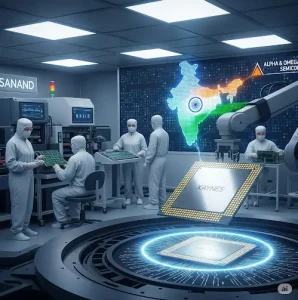Parents often hand mobile devices to their children, inadvertently exposing them to sexual exploitation and abuse that could ruin their lives, writes Satyen K. Bordoloi.
Before the advent of mobile and the internet, parents had simple yet strict rules for their wards. They were told not to talk to strangers or accept anything, no matter how enticing, from them. They were taught to look both ways while crossing the road and never to venture into unfamiliar places. Today, toddlers are given mobiles before they can even grasp their parents’ fingers. This means that by their teens, they’ve done everything that was prohibited to previous generations: they’ve talked to strangers online, carelessly ventured into unfamiliar digital corners, accepted invites, and chatted with strangers and potential predators.

The result is an increase in child sexual abuse, children being used for pornography, and the kidnapping of teens and young adults for sexual exploitation. AI has worsened matters, with AI image generators being used to create child pornography and blackmail kids. The digital world has become a shark-infested ocean full of traps and mines carefully laid for our children. Thus, cheap internet in India has also meant easy access for these predators to our children.
CHILD PORNOGRAPHY IN INDIA:
In 2022, the chief of Delhi’s Women’s Commission, Swati Maliwal, shocked the nation by revealing that child pornography i.e. Child Sexual Abuse Material (CSAM) in India, has not only risen but is available on Twitter for Rs. 20. Data tabled in parliament show the extent of this menace. Child pornography cases saw a massive jump of 1600% between 2018 and 2022 from 44 to 738 cases, and arrests went up from 36 to 372. UP and Kerala showed the highest cases, with Kerala also showing the greatest number of arrests. The National Crime Records Bureau (NCRB) data shows that in 2021 alone, over 1000 minor girls were abducted across the country for sex, prostitution, and pornography – a vast majority of them in semi-rural and rural areas. Bihar recorded the highest number of cases regarding the use of children for pornographic material, followed by Jharkhand, Tamil Nadu and Rajasthan.
And if you thought only girls were abused, you’re mistaken. Both minor girls and boys have faced sexual exploitation and blackmail.

Yet, these statistics do not paint the real picture and extent of the problem. For example, between 2016 and 2020, the National Commission for Protection of Child Rights (NCPCR) received only 56 complaints of child sexual exploitation content online. However, a general survey of just the arrests made in India paints a much grimmer picture. Let’s take just a few cases from 2023.
Kerala seems to have the best track record in cracking down on child pornographers. Under an operation called P-Hunt, in November 2023, the Kerala Police arrested 10 people in simultaneous raids across the state, registering 46 cases about viewing and sharing of child sexual abuse content and flagged 600 people for related offences.
In July, five individuals – hailing from five different states – were arrested in Goa over allegations of transmission, storage and viewing of CSAM. In the same month, acting on a tip from the US-based National Center for Missing and Exploited Children to the Ministry of Home Affairs (MHA) regarding child pornography videos online, five people were arrested in Ludhiana. In December around 160 cases were registered by Delhi Police along with 80 arrests in just 36 hours after complaints from NCRB. This was possible because they worked with a US-based private organization that shared 500 such cases with them. Eight people were booked in Indore in July for uploading CSAM on social media.

You just need to type ‘police, child pornography, India’ on Google, and you’ll be shocked to see not just the extent of the arrests in India, but also how a back-of-the-envelope calculation shows that the data tabled in parliament does not match what you find with such a simple search.
The problem is immense, and the authorities in India may not be as vigilant as they should be. However, the issue is not solely with the authorities. It involves all of us: you and me. We are partly responsible for this problem, mostly indirectly and unintentionally. Consider this: where do these pornographers obtain or create CSAM material? Naturally, none of us would ever allow anything like this to happen to our children. Yet, what we – YOU – may not realize is that we might inadvertently be throwing our children into the jaws of these sharks.

(Image Credit: Lexica Art)
How Child Pornography Propagates in India:
You will hear this refrain from every parent in India: today’s kids know how to operate digital devices better than us. Many take pride in the fact that their children, sometimes as young as 5 or 6, can operate their mobiles, tablets, and laptops better than them. This is true, but what these people don’t realize is that this is not a feature, but a dangerous bug. Kids being smarter than their parents in dealing with digital devices means they can access them in ways their parents don’t know and can’t monitor. In my surroundings, I have seen teens – denied by their parents – taking the phones of relatives to log on to Facebook, Instagram, Snapchat, etc. to connect with communities, groups, and people their parents have no clue about or prohibit. Some teens are into online gaming. Here too, they can meet people from down the road to someone 5,000 miles away. While most of these conversations could be innocent, the danger arises when a predator is lurking, waiting to lure children.

Children and teens are gullible, especially if they live in an abusive or unsupportive household. A little praise from a stranger can melt their defences, making them vulnerable to harmful advances. This vulnerability can begin with an exchange of simple photos, progress to video chats, and over time, lead to predators asking for nude pictures, videos, or even live naked chats. Once children give in after some persuasion, the exploitation begins. They could be blackmailed into performing sexual acts, their photos and videos could be uploaded online, and their mental peace and life could be forever ruined.
The advent of artificial intelligence has exacerbated the situation. There are websites where one can upload a regular picture, and the sites ‘undress’ the subjects using AI, making it appear as if they are not wearing anything. Other sites help morph faces over naked bodies. Thus, even a normal photo shared by a child with a predator could be transformed into a nude image using AI, which can then be used to blackmail the child.

THE PROBLEM WITH LAW ENFORCEMENT IN INDIA:
India has some of the strictest laws against Child Sexual Abuse Material (CSAM), especially under Sections 14 and 15 of the POSCO Act. Section 14 deals with punishment for using children for pornographic purposes, while Section 15 outlines punishment for storing pornographic material involving children. The problem, therefore, is not the law. The issue is that our investigative and enforcement agencies often lack the necessary understanding of these laws or the ability to enforce them.
The major issue is this: our police, IB, CBI, ED, and other agencies tasked with dealing with this menace often struggle to understand such cases because they involve the digital medium. In earlier pieces, we discussed how cases of cyber fraud are on the rise, with the police finding themselves ill-equipped to handle them. Just as children at home are often more digitally savvy than their parents, the police in India are far behind cybercriminals, including those who engage in CSAM and sextortion. There is an urgent need not only to update and educate our policing and law enforcement agencies about child sexual abuse and the content created from it but also to establish a cyber cell department in every police station in the country. As our lives become increasingly digital, so do crimes – both economic and otherwise. For policing to keep up with the times, at least half of their force needs to be experts in online crimes. Only then can CSAM be truly monitored and regulated.

(Image Credit: jcomp on Freepik)
Yet, beyond all this, we must remember that the first line of defence, the first place where child sexual abuse and sextortion can be prevented, is at home. Using YouTube to quieten a crying toddler is a quick fix in the modern nuclear family, but this early exposure to the World Wide Web can have severe repercussions for our children. Anything online is a door to the world. You wouldn’t open your house doors to let the whole world rush in unregulated, so why would you do the same in the digital space? Unless we realize this and act accordingly, none of our children will be safe.
In case you missed:
- India’s Upcoming Storm of AI Nudes & Inspiring Story Of A Teen Warrior
- Black Mirror: Is AI Sexually abusing people, including minors? What’s the Truth
- Tears of War: Science says women’s crying disarm aggressive men
- Pressure Paradox: How Punishing AI Makes Better LLMs
- Digital Siachen: Why India’s War With Pakistan Could Begin on Your Smartphone
- AI Washing: Because Even Your Toothbrush Needs to Be “Smart” Now
- A Teen Suicide Spotlights Dangers of Unregulated AI Companions
- What are Text-to-Video Models in AI and How They are Changing the World
- Susan Wojcicki: The Screaming Legacy of The Quiet Architect of the Digital Age
- AI’s Top-Secret Mission: Solving Humanity’s Biggest Problems While We Argue About Apocalypse










